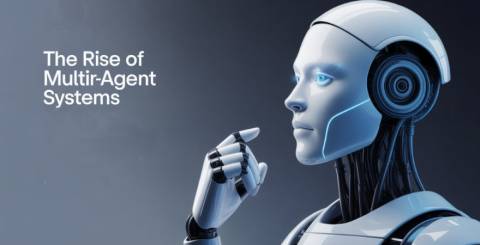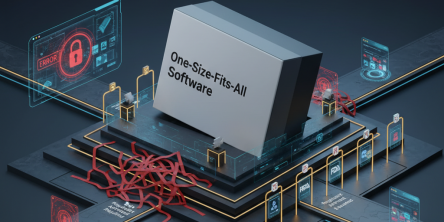The Rise of Multi-Agent Systems: How Teams of AI Agents Solve Complex Problems

Not long ago, the idea of multiple AI agents working together, each with a specific role, collaborating to solve problems, felt like science fiction. Today, it’s becoming a defining shift in how enterprises approach automation, intelligence, and decision-making. We’re moving from single AI models that handle isolated tasks to multi-agent systems that operate like digital teams, each contributing expertise toward a shared goal.
For business leaders, this is not just a technology story. It’s a story about coordination, adaptability, and how organizations can achieve breakthroughs by letting intelligent systems work together, just like high-performing human teams.
From Single Agents to Collective Intelligence
Until recently, AI systems largely functioned as lone specialists. A chatbot handled support. A model forecasted sales. A tool for automated data entry. Each worked independently, often creating data silos or requiring human oversight to connect the dots.
Multi-agent systems change that. They introduce collaborative intelligence, where multiple agents, each designed with unique goals or functions, communicate, negotiate, and act in coordination. Together, they can solve problems that are too complex or dynamic for a single model to handle.
Imagine a company’s AI ecosystem as a digital organization:
- One agent analyzes customer behavior.
- Another monitors operations.
- A third identifies supply chain risks.
- A fourth coordinates actions across them all.
These agents talk to one another, exchange insights, and make decisions based on shared context. The result is a more fluid, intelligent system that can adapt faster and respond to real-world changes almost in real time.
Why Multi-Agent Systems Are Emerging Now
The rise of multi-agent systems isn’t happening in isolation. Three converging trends are making them viable and necessary for modern enterprises:
The explosion of specialized AI models – We now have domain-specific models trained for marketing, logistics, finance, and healthcare. Integrating their outputs through a multi-agent framework brings synergy rather than fragmentation.
The shift to autonomous operations – As organizations push toward autonomy in decision-making and process optimization, coordinating multiple agents becomes the key to managing complex workflows without human micromanagement.
The need for speed and adaptability – Business environments shift daily. Multi-agent systems can dynamically reassign roles, reprioritize tasks, and respond faster than traditional rule-based automation.
This combination is turning multi-agent systems into a foundation for enterprise AI maturity.
How Multi-Agent Systems Work in Practice
Think of a multi-agent system as an intelligent network. Each agent has its own objective, data access, and decision-making ability. The magic lies in how they coordinate.
1. Autonomy and Role Specialization
Every agent operates independently, focusing on one part of the problem such as data cleaning, forecasting, sentiment analysis, or optimization. This division of labor mirrors how departments function within a company.
2. Communication and Collaboration
Agents share information through structured protocols like APIs, message queues, or shared data layers. They discuss findings, cross-check assumptions, and collaborate to make collective decisions.
3. Coordination and Decision Logic
A “controller” or “orchestrator” agent manages overall coordination. It assigns tasks, reconciles conflicts, and ensures alignment with the organization’s objectives.
This ecosystem creates an effect greater than the sum of its parts, emergent intelligence, where coordinated actions generate more value than isolated outputs.
Real-World Examples of Multi-Agent Systems
The concept is already taking root across industries.
1. Financial Services: Smarter Risk and Compliance
Banks use AI Agents for Finance to track transactions, detect fraud, assess credit risk, and monitor compliance, all working in unison. One agent flags anomalies, another validates them against historical data, while a third triggers alerts or corrective actions. This reduces false positives and shortens response times.
2. Manufacturing: Autonomous Production Optimization
In factories, AI agents for manufacturing monitor machine health, predict maintenance schedules, and manage inventory. When a machine shows early signs of wear, these agents coordinate to adjust production schedules and reorder components automatically, minimizing downtime and waste.
3. Retail and eCommerce: Dynamic Personalization
Retailers are deploying teams of agents for pricing, demand forecasting, and customer engagement. For instance, Ecommerce AI Agents personalize products while a pricing agent adjusts offers based on inventory, and a logistics agent ensures timely delivery, all aligned toward improving customer experience and revenue.
4. Healthcare: Coordinated Care Delivery
In hospitals, Healthcare AI Agents are helping coordinate care pathways. Diagnostic agents analyze scans, scheduling agents manage patient flow, and inventory agents ensure critical supplies are stocked, all feeding into a central decision system that improves both efficiency and patient outcomes.
These examples highlight one thing: multi-agent systems are not just an AI strategy; they are an organizational strategy.
What Makes Multi-Agent Systems So Powerful
Beyond efficiency, multi-agent systems introduce three distinct advantages that reshape how leaders should think about enterprise AI.
1. Decentralized Decision-Making
Instead of routing every decision through a single system, agents decide locally and act collectively. This decentralization improves resilience, especially in large or distributed organizations.
2. Continuous Adaptation
Agents can evolve independently. If one agent learns a better way to perform its task, others can adapt accordingly, creating a self-improving ecosystem that grows more intelligent over time.
3. Human-AI Collaboration
Humans remain part of the loop. Leaders can guide priorities, set constraints, or approve high-impact decisions. AI agents handle execution, coordination, and optimization at scale. This balance ensures both control and agility.
The Leadership Perspective: What Should You Be Doing Now?
For decision-makers, the rise of multi-agent systems signals a shift in how digital transformation should be approached. It’s not just about implementing AI; it’s about designing an intelligent ecosystem where multiple agents and humans work together seamlessly.
Here’s how to start:
1. Map Your AI Ecosystem
Identify where you already have isolated AI systems or automation tools. Think of them as “agents” waiting to collaborate.
2. Define Clear Roles and Goals
Each agent should have a defined purpose such as marketing optimization, risk analysis, customer retention, or resource allocation. Clarity ensures collaboration without chaos.
3. Establish Communication Pathways
Integrate systems through shared APIs or orchestration layers. A strong data foundation is essential for agents to exchange information effectively.
4. Prioritize Governance and Observability
As agents act autonomously, oversight becomes critical. Implement monitoring and audit mechanisms to track agent decisions, ensure compliance, and maintain ethical boundaries.
5. Start Small, Then Scale
Begin with a few agents collaborating on a specific process such as lead management or inventory optimization. Once value is proven, expand across departments and workflows.
For organizations investing in AI agent development, this approach helps move from scattered automation to coordinated intelligence, setting the stage for scalable, governable, and high-impact AI systems.
Beyond Technology: A Cultural Shift
Multi-agent systems don’t just change your tech stack; they change how your organization thinks. They demand a mindset where collaboration, adaptability, and delegation extend beyond people to intelligent systems.
This shift challenges traditional structures. It asks leaders to think of AI not as a tool, but as a team one that learns, communicates, and collaborates toward shared goals.
Organizations that embrace this mindset early will build digital ecosystems that are faster, smarter, and far more resilient than their competitors. Those that don’t risk being left with isolated, underutilized AI systems that never reach their full potential.
The Next Chapter of Enterprise AI
The age of the single AI model is giving way to the era of collaborative intelligence, where multiple AI agents work together, continuously learning from each other, guided by human leadership.
Multi-agent systems are not a passing trend. They represent a new architecture for problem-solving, one that mirrors how real organizations thrive: through coordination, communication, and shared purpose.
Leaders who act now will not just automate processes; they’ll redefine how intelligence operates across their enterprise. Because in the coming years, the most successful organizations won’t just use AI. They’ll build teams of AI agents that think, learn, and act together, just like humans, only faster.
Similar Articles
In today’s data-driven world, choosing the right business intelligence (BI) platform can make or break your organization's analytics success.
We all know that companies today are no longer limited to a single physical location. Work processes are also no longer strictly isolated.
It is neither secret nor news that the mind-boggling pace of digital transformation around us has totally altered consumer expectations.
In the world of finance, speed and accuracy are everything. Decisions made a day late can cost millions, and delayed visibility into financial performance can leave even the best organizations blind to risks.
Discover the best tools to enhance employee recognition, boost morale, and create a more motivated, engaged workplace culture.
At first glance, off-the-shelf software appears to be a dream come true. They are quick to set up, cheaper upfront, and marketed as “universal.”
A modern business must continually adapt. This bit everyone seems to know.
The modern healthcare industry is undergoing a significant transformation. The models of healthcare that we are used to thus far are now making way for a more data driven approach
In the modern world, maintaining good health often feels like a constant challenge. Between busy lifestyles, sedentary habits, and lack of motivation, many people find it difficult to stay consistent with exercise, diet, or wellness practices.









